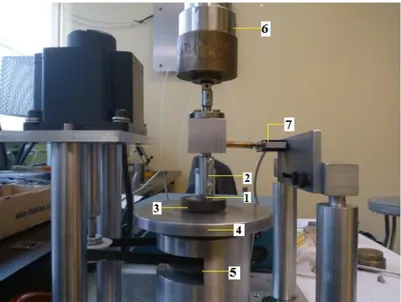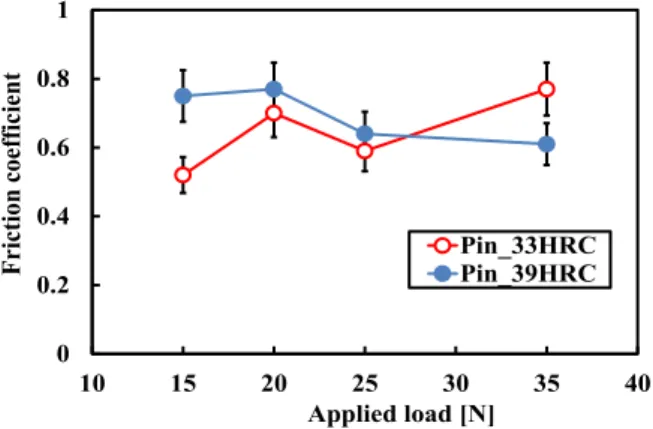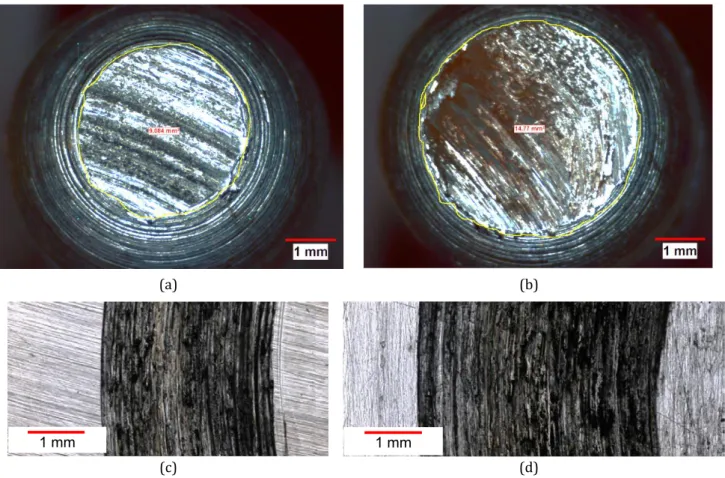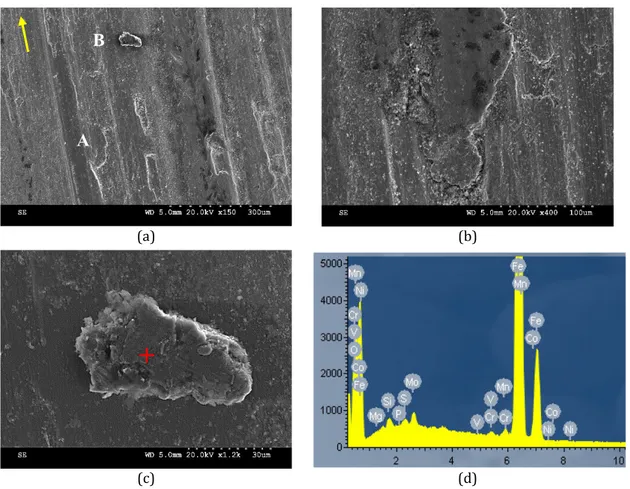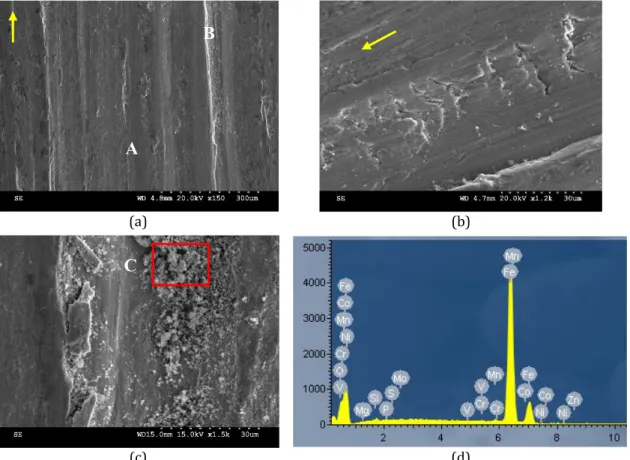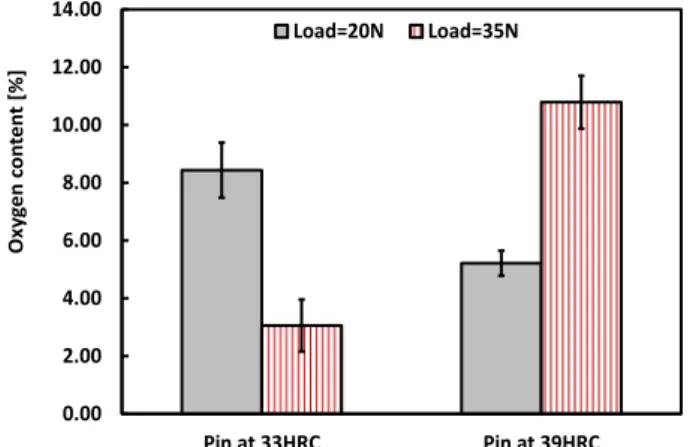Title:
Tempered AISI 4140 Steel Against Hardened AISI 1055 Steel
Auteurs:
Authors:
A. Elhadi, A. Bouchoucha, W. Jomaa, Y. Zedan, Thomas Schmitt et
P. Bocher
Date: 2016
Type:
Article de revue / Journal articleRéférence:
Citation:
Elhadi, A., Bouchoucha, A., Jomaa, W., Zedan, Y., Schmitt, T. & Bocher, P. (2016). Study of Surface Wear and Damage Induced by Dry Sliding of Tempered AISI 4140 Steel Against Hardened AISI 1055 Steel. Tribology in Industry, 38(4), p. 475-485. Tiré de http://www.tribology.fink.rs/journals/2016/2016-4/...
Document en libre accès dans PolyPublie
Open Access document in PolyPublieURL de PolyPublie:
PolyPublie URL: https://publications.polymtl.ca/3605/
Version: Version officielle de l'éditeur / Published versionRévisé par les pairs / Refereed Conditions d’utilisation:
Terms of Use: CC BY
Document publié chez l’éditeur officiel Document issued by the official publisher
Titre de la revue:
Journal Title: Tribology in Industry (vol. 38, no 4)
Maison d’édition:
Publisher: Serbian Tribology Society
URL officiel:
Official URL: http://www.tribology.fink.rs/journals/2016/2016-4/...
Mention légale:
Legal notice:
Ce fichier a été téléchargé à partir de PolyPublie, le dépôt institutionnel de Polytechnique Montréal
This file has been downloaded from PolyPublie, the institutional repository of Polytechnique Montréal
Tribology in Industry
www.tribology.fink.rsStudy of Surface Wear and Damage Induced by Dry
Sliding of Tempered AISI 4140 Steel against
Hardened AISI 1055 Steel
A. Elhadi
a, A. Bouchoucha
b, W. Jomaa
c,d, Y. Zedan
c, T. Schmitt
e, P. Bocher
caDepartment of Mechanical Engineering, University of Mohamed Boudiaf, Msila, Algeria,
bDepartment of Mechanical Engineering, University of Constantine, Algérie, c Department of Mechanical Engineering, ÉTS, Montréal, Canada,
dDepartment of Mechanical Engineering Laval University, Québec, Canada, eDepartment of Physics Engineering, Polytechnique Montréal, Montréal, Canada.
Keywords: Steels Hardness Friction coefficient Wear rate Surface damage A B S T R A C T
In industry, the sliding mechanical systems are subject to friction and wear phenomena. These phenomena can be the origin of a reduction of the efficiency of the mechanical system even to be responsible for its incapacity. Generally, the materials of the parts which are moving relative (tribological couple) of these systems are low alloy steels and carbon steels, thanks to their good mechanical and tribological properties. The present work aimed to study, the surface wear and damage induced by dry sliding of hard carbon steel AISI 1055 (disc) against tempered low alloy steel AISI 4140 (pin) with different hardness and applied loads was investigated. The results revealed that the interaction between the applied load and pin hardness result in complex thermo-mechanical behaviour of the worn surfaces. When a lower hardness pin is used, the main wear mechanisms observed on the discs were abrasion, adhesion, and oxidation. When a higher hardness pin is used, the wear of the discs is governed by delamination, oxidation, and plastic deformation. In particular, third-body wear occurs at high applied load resulting in higher wear rate of high hardness pins compared to low hardness pins.
© 2016 Published by Faculty of Engineering Corresponding author:
Abdelmalek Elhadi
Department of Mechanical
Engineering,University of Mohamed Boudiaf, Msila, Algeria
E-mail: elhadimalek65@gmail.com
1. INTRODUCTION
Low alloy steels are the most used material for machines elements industry because of their high mechanical properties [1]. It was observed by several researchers [2,3] that the variation of friction depends on interfacial conditions such as normal load, geometry, relative surface
motion, sliding velocity, surface roughness of the rubbing surfaces, type of material, system rigidity, lubrication and vibration. In many metal pairs, in the high load regime, the coefficient of friction decreases with load [4]. Friction coefficient and wear rate of metals and alloys showed different behavior under different operating conditions [5,6]. Therefore,
R
ES
EA
R
addressing the wear mechanism regimes have generated a large number of research topics in friction and wear by sliding fields [7].
The main steel selection criteria for parts submitted to wear is usually based on the surface hardness of the component [8].
Many variables may affect the wear mechanism which makes it a complex phenomenon. Among these variables are service conditions (such as mating partners, normal load, sliding speed, temperature and surface finish of the couple tribological parts), environmental parameters (atmospheric or sea environment) and other factors like lubrication or corrosion [1,9]. The wear rate can also be related to other factors such as microstructure and its features, hardness, work hardening index, fracture, and fatigue properties [10-13].
The difference in hardness of the mating parts has a decisive influence on the contact surfaces life. Several studies have investigated the effect of hardness on the wear mechanisms of unlubricated sliding wear of steels [14-16]. It is well reported that sliding wear is driven by abrasion, adhesion, and delamination processes [17]. On one hand, the process of delamination is caused by the nucleation of voids. Their growth and subsequent coalescence are favoured by strained material under severely sliding conditions [18, 19]. On the other hand, the abrasion and adhesion wear mechanism may be attributed to the fragmentation of the softer material which cause to form wear debris. It was reported that fragment formation is the result of the local increase of dislocation density; consequently, fragment can be formed after strain accumulation.
Experimental results have been reported that the small debris particles created by plastic deformation (abrasion, adhesion, etc.) are trapped in the contact zone and cannot be easily removed [17]. Thus, the situation changes from two to three bodies contact conditions consisting of two counterparts and the debris [20]. The third body particles affect the displacement in the contact zone and thus affect the coefficient of friction [21]. Due to the energy dissipated in the contact (mechanical and thermal), the wear particles can oxidized and become hard abrading oxides which thus
increase the wear rate, or they can isolate the surfaces and have a protective role so that reducing the wear rate [22]. Others [12] attributed the change in the frictional regime to the cyclic formation/detachment of coarse debris in the case of low hardness/ductile materials. It has been shown that a decrease in the friction coefficient with an increase in normal load can be attributed to an increase in frictional heating of the slider and a consequent decrease of material strength [23].
As only few studies have addressed the effect of tempered martensite on the wear behaviour in dry sliding conditions, the present study aims to investigate the wear behaviour of low alloy steel AISI 4140 against carbon steel AISI 1055, which are commonly used in the manufacturing of the parts of the sliding mechanism. The analyses were made by performing pin-on-disc wear tests, under various loads for fixed sliding speed. Different pin (AISI4140) hardness were tested while the disk hardness (AISI1055) was kept harder than the pin. Such study of wear behaviour with different heat treatment may
provide a proper selection of
typical‒hardness‒steel for sliding application.
2. MATERIALS AND METHODOLOGY
2.1 Materials
The materials chosen in this investigation are AISI 4140 and AISI 1055 steels for the pin and disc, respectively. The chemical compositions of both steels are displayed in Table 1. The pins were quenched and tempered to 33HRC and 39HRC while discs were quenched and tempered to 52HRC. The microstructures of the pins are composed mainly by tempered martensite for both steels with the presence of some bainite for low hardness (33HRC) one as shown in Fig. 1.
2.2 Methodology
Dry sliding wear tests were conducted according to the ASTM G99-5 (2010) standard using a pin-on-disc system (Fig. 2). The linear sliding velocity was kept constant at 0.5 m/s for all tests. All wear tests were carried in air at ambient temperature and relatively humidity of ~35 %. The normal load was varied between 15
and 35 N. A sliding time of 900 s was selected for the tests, allows reaching a steady state in friction. Before each test, both the disk and the pin were cleaned with acetone, and each specimen was tested on fresh track. The test pins were weighed initially, and at the end of each wear test. They were wiped clear of wear particles, degreased and re-weighed. The difference in weights of test pin, before and after the experiment, determines the weight loss, which was used for calculating the volume of material lost. The latter was studied as function of the applied load for each steel samples. The worn mass of the pin specimen were measured
by a precise electric-balance (10-4 mm). The worn surfaces were analysed with 3D measuring laser microscope (Lext OLS4100 from Olympus) and a HITACHI S-3600N scanning electron microscopy (SEM).
The friction coefficient was calculated as the ratio between the friction force and the normal load. The average value from steady state regime was considered. The start of the steady state regime was selected as the sliding time at which the standard deviation of friction coefficient became lower than the 10 % of its average value.
Table 1. Nominal chemical composition (Wt. %) of AISI 4140 and AISI 1055 steel.
Element C Cr Mo Mn Si P S
AISI 4140 0.38 - 0.43 0.80 - 1.1 0.15 - 0.25 0.75 - 1.0 0.15 - 0.30 ≤0.035 ≤0.040
AISI 1055 0.50 - 0.60 0.60 - 0.90 ≤ 0.040 ≤0.050
(a) (b)
Fig. 1. Optical microstructures of AISI4140 steel tempered at a hardness of (a) 33HRC and (b) 39HRC.
Fig. 2. Pin-on-disc system: (1) Pin; (2) Pin holder; (3) Test disc; (4) Support; (5) Speed reducer; (6) Normal load (dead weight); (7) Load cell for frictional force.
3. RESULTS AND DISCUSSION 3.1. Friction and wear behavior
The variation of the friction coefficient over the sliding time can be seen in Fig. 3. The evolution of the friction coefficient experiences a running-in period durrunning-ing the first hundreds of seconds followed by a relatively steady state friction regime. The duration of the running-in period is found to vary with the applied load and the pin hardness. For the steady state period, the friction coefficient curves exhibit different behaviours, involving low and high friction plateaux. This is specifically true for the low hardness pins and applied loads of 20 N, 25 N, and 35 N (Fig. 3a). This phenomenon is observed only at applied load of 25 N for high hardness pin (Fig. 3b). Moreover, the frequency of the transition from one regime to another over the sliding time varies with the applied load and the pin hardness. The observed friction coefficient evolution with time and applied load suggests that changes in the wear mechanism and/or temperature at the contact interface may be taking place for different applied load as suggested by [12].
(a)
(b)
Fig. 3. Friction coefficient as function of sliding time for (a) Pin tempered at 33HRC, and (b) Pin tempered at 39 HRC. 0 0.2 0.4 0.6 0.8 1 10 15 20 25 30 35 40 Fr iction coe ffic ient Applied load [N] Pin_33HRC Pin_39HRC
Fig. 4. Effect of the applied load on the average friction coefficient with relative standar deviation. The average values of the friction coefficient, measured in the steady-state condition (from 600 to 900 sliding distance) are plotted vs. applied load in Fig. 4. The average values of the friction coefficient are in the range [0.5, 0.8] which is generally found in dry sliding friction of steels [12,7]. The applied load affects the friction coefficient in different manner and no specific trend was observed, particularly for low hardness pins. In fact, the high hardness pins have seen their friction coefficients decrease with increasing the applied load. Whereas the low hardness pins have seen the opposite. Compared to the low hardness pin, the high hardness pin produces high friction coefficients except for the highest applied load (35 N). Thus, SEM analysis will be done in the next section to highlights the actual wear mechanisms operating in the proposed frictional systems and try to rationalize the obtained results. 0.E+00 1.E-06 2.E-06 3.E-06 4.E-06 5.E-06 6.E-06 7.E-06 10 15 20 25 30 35 40 W ear rat e [mm³/m m] Applied load [N] Pin_33HRC Pin_39HRC
Fig. 5. Effect of the applied load on the wear rate with relative standar deviation.
Figure 5 shows the wear rate (per sliding distance) as a function of applied load. In general, the wear rate increases with the applied load. Surprisingly, the high hardness pins wear faster for high applied load than the low
hardness pins. This finding is in disagreement with the classical theory of sliding wear which postulates that the harder is the material, the higher is its wear resistance, unless specific wear mechanisms took place during sliding as argued in [12,24]. Studying the wear mechanisms of pin and disc under the tested conditions will provide some explanations for this behaviour.
3.2. Worn Surfaces analysis
In order to identify the wear mechanisms, worn surface of pins and tracks have been analyzed by optical microscopy and SEM techniques. Figure 6 displays examples of optical images of worn pins and tracks. For the highest load (35 N), the worn surface of the high hardness pin is larger (Fig. 6b) than the low hardness one (Fig. 6a). Moreover, the high hardness pin experiences high level of oxidation (Fig. 6b). The worn area of the tracks follows the same trend depicted in Figs. 6c and 6d. Moreover, Fig. 7 shows that the wear track is significantly larger and deeper for the high hardness pin than for the low hardness one for the same loading condition of 35 N. SEM observations allowed the identification of typical damage features into the worn surfaces as a function of normal load and pin hardness (Figs. 8, 9, and 10). For low hardness pin and the applied load (20 N), the worn profile (Fig. 8a) presents a rough surface with damage features constituted mainly by local adhesive scars (Fig. 8b) and particles (Fig. 8c). The presence of chromium and molybdenum (Fig. 8d) indicates that these particles come from the pin material. It is suggested that these debris are the results of the micro-chipping and fragmentation of the low hardness pin material most likely induced by cumulative plastic shearing as suggested in Lepesant et al. [25]. When the highest load is applied (35 N), the worn surface of the track becomes smoother with abrasion marks that can be described as micro-ploughing and relatively narrow scars in the direction of sliding are formed and some adhered material layers are found (Fig. 9a). SEM micrograph (Fig. 9b) highlights the plastic deformation on this layer where the plastic flow lines and some micro-cracks are visible suggesting that the surface material has underwent high contact stresses during sliding. Once again, EDS analysis reveals
the presence of oxygen and chromium indicating that this layer is mainly composed of agglomerated and compacted oxidised third body particles of oxide from the pin material. For high hardness pin used at applied load of 20 N, the track worn surface presents micro-grooving and smooth surface with ploughing marks (Fig. 10a). A close examination of the ploughing marks indicates the presence of severe plastic deformation and cracking (Fig. 10b) which was note visible for low hardness pin at the same applied load. Moreover, micro-chipping and resulting fine particles were observed on the formed micro-grooves (Fig. 10c) attesting the high shearing and rupturing mechanisms in agreement with a higher Young’s modulus which will increases the contact pressure when high hardness pins are used even at low applied load (20 N). EDS analysis confirmed that these particles are mainly composed of oxidized material from the disc as no/very few chromium element has been detected (Fig. 10d). At applied load of 35N induces severely damage on the track surface as can be seen in (Fig. 11a). The main damage features include delamination (Fig. 11b) and severe plastic deformation (Fig. 11c). In the micro-delamination features, small flakes of material are pulled out from the surface (Fig. 12b). As for the load 20 N, the adhering material for the higher applied load (35 N) is mainly composed of the disc material as confirmed by the EDS spectrum in Fig. 11d.
Additional EDS analyses were performed over larger areas (~1 mm × 1 mm) in the wear track to highlights the effect of the applied load and pin hardness on the main wear mechanisms. The EDS spectrums give evidence of oxidative wear. One can observe significant interaction between the applied load and pin hardness regarding the amount of oxygen on the wear products (Fig. 12). In fact, the oxygen content decreases when increasing the applied load for the low hardness pin, the inverse been true for the high hardness pin. Figure 13 displays the effect of applied load and pin hardness on the chromium content. It is clear that the applied load do not affect the chromium content. However, the high hardness pin produces lower chromium content into the worn track as compared to the low hardness one.
(a) (b)
1 mm 1 mm
(c) (d)
Fig. 6. Optical images of worn surfaces at load of 35N: (a) Worn pin tempered at 33 HRC, (b) Worn pin tempered at 39 HRC, (c) Worn disc with pin tempered at 33 HRC, and (d) Worn disc with pin tempered at 39 HRC.
(a)
Evaluation length [µm] (b)
Fig. 7. Worn track profiles for pins at (a) Hardness of 33HRC and (b) High hardness of 39HRC.
He ight [ µm] He ight [ µm]
(a) (b)
(c) (d)
Fig. 8. (a) SEM micrographs of worn tracks with pin tempered at 33 HRC and applied load of 20 N, (b) Delamination (zone A), (c) Adhering particle (zone B), and (d) Corresponding EDS spectrum.
(a) (b)
(c)
Fig. 9. (a) SEM micrographs of worn tracks with pin tempered at 33 HRC and applied load of 35N, (b) Adhering layer, and (c) Corresponding EDS spectrum.
A
B
+
(a) (b)
(c) (d)
Fig. 10. (a) SEM micrographs of worn tracks with pin tempered at 39 HRC and applied load of 20N, (b) Plastic deformation (zone A), (c) Micro-chipping and fragmented debris (zone B), and (d) EDS spectrum of zone C.
(a) (b)
(c) (d)
Fig. 11. (a) SEM micrographs of worn tracks with pin tempered at 39 HRC and applied load of 35N, (b) Adhering particles and delamination (zone A), (c) Plastic deformation (zone B), and (d) EDS spectrum of the adhering particle (zone A).
B
A
C
+
A
B
0.00 2.00 4.00 6.00 8.00 10.00 12.00 14.00 Pin at 33HRC Pin at 39HRC O xy gen c on ten t [%] Load=20N Load=35N
Fig. 12. Oxygen content versus pin hardness at different applied load.
0.00 0.05 0.10 0.15 0.20 0.25 0.30 0.35 0.40 Pin at 33HRC Pin at 39HRC Chr omium c on ten t [%] Load=20N Load=35N
Fig. 13. Chromium content versus pin hardness at different applied load.
The wear mechanisms operating on the pin surface are strongly related to those operating on the track side and several scenarios can operates as the interaction between the applied load and pin hardness result in complex thermo-mechanical behaviour of the worn surfaces. This change of mechanisms can explain the unstable trend of the wear rate and friction coefficient with regard to the applied load and pin hardness. When high load is applied (35 N), the high hardness pin induces high level of disc material loss in the form of small debris. These debris, which are harder than the pin material generate in turn high level of wear rate by abrasion on the pin surface. The same mechanism is applied to the low hardness pin but with low level of generated debris volume resulting in lower erosion rates. For the high hardness pin, the wear mechanisms are governed by delamination, oxidation, and plastic deformation and fracture. In the case of low hardness pin, the main wear mechanisms observed were abrasion, adhesion, and
oxidation. Specifically, the oxidative wear is found to be governed by the applied load for both tempered pins used in this study.
Lepesant et al. [25] argued that, in a specific friction conditions, compacted oxide particles from the pin, can plastically deformed to form a layer, referred to as a glaze layer. It is shown that the matrix strength of the pin material has to be considered to know whether the oxides from the glaze layers are protective, or not, against wear [26]. If the matrix is strong enough, the oxides formed during friction have a positive influence on wear. On the contrary, if the matrix is not strong enough, the oxides from the glaze layer do not protect the surfaces from wear and they may even act as an abrasive third body. In the present study, we suggested that the oxides from the glaze layer plays a positive role in improving the wear resistance of the low hardness pin as compared to the high hardness pin results regarding to the obtained wear rate trends (Fig. 5).
4. CONCLUSIONS
The present study investigated the wear mechanisms of tempered low alloy steel against hardened carbon steel under dry sliding wear. Based on the obtained results, the following conclusions may be drawn:
In specific tribological conditions, low
hardness pin can perform better, than high hardness pin in terms of dry sliding wear resistance.
Wear mechanisms of the hard track material (disc) should be considered as three-body contact wear which is mainly governed by the hard particles detached from the worn disc and pin.
Under high applied loads, it is shown that
when high hardness pins are used, the disc generates amount of particles/debris that significantly increases the wear of the pin. This can be avoided by using a pin with a slightly lower hardness.
The obtained results can be considered as
a preliminary investigation for improving the performance of the sliding mechanism.
Acknowledgments
The authors appreciate the financial support from the Mechanical Engineering Department of the Faculty of technology, University of Mohamed Boudiaf, Msila, Algeria. The authors are also grateful for the technical support of the Department of Mechanical Engineering, ÉTS, Montreal, Canada through the Laboratoire d’Optimisation des Procédés de Fabrication en Aérospatiale, LOPFA.
REFERENCES
[1] N. Khanafi-Benghalem, E. Felder, K. Loucif and P. Montmitonnet, 'Plastic deformation of 25CrMo4 steel during wear: Effect of the temperature, the normal force, the sliding velocity and the structural state', Wear, vol. no. 268, pp. 23-40, 2010.
[2] M.B. Peterson and W.O. Winer, Wear Theory and Mechanisms, Wear Control Handbook. ASME, New York, NY, pp. 35-80, 1980.
[3] B. Bhushan,Principle and Applications of Tribology. New York: John Wiley & Sons, Inc, 1999.
[4] M.A. Chowdhury and D.M. Nuruzzaman, 'Experimental Investigation on Friction and Wear Properties of Different Steel Materials', Tribology in Industry, vol. 35, no. 1, pp. 42-50, 2013.
[5] M.A. Chowdhury, M.M. Helali, 'The Effect of Relative Humidity and Roughness on the Friction Coefficient under Horizontal Vibration', The Open Mechanical Engineering Journal, vol. 2, pp. 128- 135, 2008.
[6] M. Kandeva, L. Vasileva, R. Rangelov and S. Simeonova, 'Wear-resistance of Aluminum Matrix Microcomposite Materials', Tribology in Industry, vol. 33, no. 2, pp. 57-62, 2011.
[7] O. Barrau, C. Boher, Gras R, Rezai-Aria F. Analysis of the friction and wear behaviour of hot work tool steel for forging', Wear, vol. 255, no. 7, pp.1444-1454, 2003.
[8] J.D. Bressana, D.P. Darosa, A. Sokolowskib, R.A. Mesquitac and C.A. Barbosad, 'Influence of hardness on the wear resistance of 17-4 PH stainless steel evaluated by the pin-on-disc testing', Journal of materials processing technology , vol. 205, pp. 353-359, 2008.
[9] H. Goto and Y. Amamoto, 'Effect of varying load on wear resistance of carbon steel under unlubricated conditions', Wear, vol. 254, no. 12, pp.1256-1266, 2003.
[10] V. Abouei, H. Saghafian and S. Kheirandish, 'Effect of microstructure on the oxidative wear behavior of plain carbon steel', Wear, vol. 262, no. 9-10, pp.1225-1231, 2007.
[11] D. Rai, B. Singh and J.Singh, 'Characterisation of wear behaviour of different microstructures in Ni–Cr–Mo–V steel', Wear, vol. 263, no. 1-6, pp. 821-829, 2007.
[12] L. Tang, C. Gao, J. Huang, H. Zhang and W. Chang, 'Dry sliding friction and wear behaviour of hardened AISI D2 tool steel with different hardness levels', Tribology International, vol. 66, pp.165-173, 2013.
[13] K. Hokkirigawa, K. Kato and Z.Z. Li, 'The effect of hardness on the transition of the abrasive wear mechanism of steels', Wear, vol. 123, no. 2, pp. 241-251, 1988.
[14] CC. Viáfara and A. Sinatora, 'Influence of hardness of the harder body on wear regime transition in a sliding pair of steels', Wear, vol. 267, no. 1, pp. 425-432, 2009.
[15] C.C. Viáfara and A. Sinatora, 'Unlubricated sliding friction and wear of steels: An evaluation of the mechanism responsible for the T1 wear regime transition', Wear, vol. 271, no. 9, pp. 1689-1700, 2011.
[16] V. Toppo, SB. Singh and KK. Ray, 'Wear resistance of annealed plain carbon steels in pre-strained condition', Wear, vol. 266, no. 9-10, pp. 907-916, 2009.
[17] V. Panin, A. Kolubaev, S. Tarasov and V. Popov, 'Subsurface layer formation during sliding friction', Wear, vol. 249, pp. 860-867, 2002. [18] J.R. Fleming and N.P. Suh, 'Mechanics of crack
propagation in delamination wear', Wear, vol. 44, no. 1, pp. 39-56, 1977.
[19] S. Jahanmir, N.P. Suh, 'Mechanics of subsurface void nucleation in delamination wear', Wear, vol. 44, no. 1, pp. 17-38, 1977.
[20] Y. Berthier, 'Third body reality-Consequences and use of the third body concept to solve a friction and wear problems', Wear, Materials, Mechanisms and Practice, DOI: 10.1002/9780470017029.ch12, 2005.
[21] N. Diomidis and S. Mischler, 'Third body effects on friction and wear during fretting of steel contacts' Tribology International, , vol. 44, no. 11, pp.1452-1460, 2011.
[22] S.Q. Wang, M.X. Wei and Y.T. Zhao, 'Effects of the tribo-oxide and matrix on dry sliding wear characteristics and mechanisms of a cast steel', Wear, vol. 269, no. 5, pp. 424-434, 2010.
[23] S. Kumar, A. Bhattacharyya, D.K. Mondal, K. Biswas and J. Maity, 'Dry sliding wear behaviour of medium carbon steel against an alumina disk', Wear, vol. 270, no. 5, pp. 413-421, 2011.
[24] Y. Wang and T. Lei, 'Wear behavior of steel 1080 with different microstructures during dry sliding', Wear, vol. 36, no. 2, pp. 213-217, 1997.
[25] P. Lepesant, C. Boher, Y. Berthier and F. Rezai-Aria, 'A phenomenological model of the third body particles circulation in a high temperature contact', Wear, vol. 298-299, pp. 66-79, 2013. [26] S. Wang, M. Wei and Y. Zhao, 'Effects of the
tribo-oxide and matrix on dry sliding wear characteristics and mechanisms of a cast steel', Wear, vol. 269, no. 5-6, pp. 424-434, 2010.
